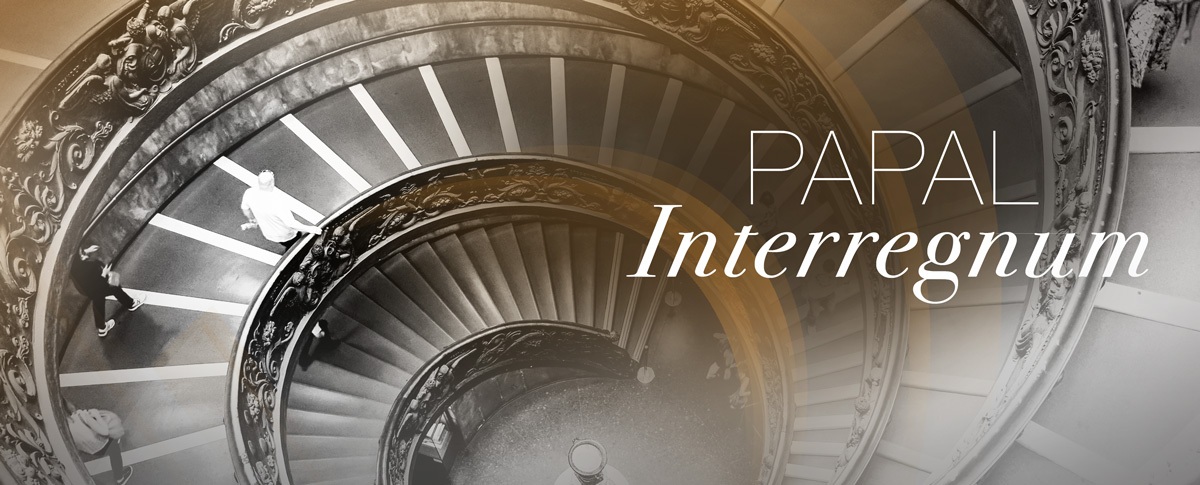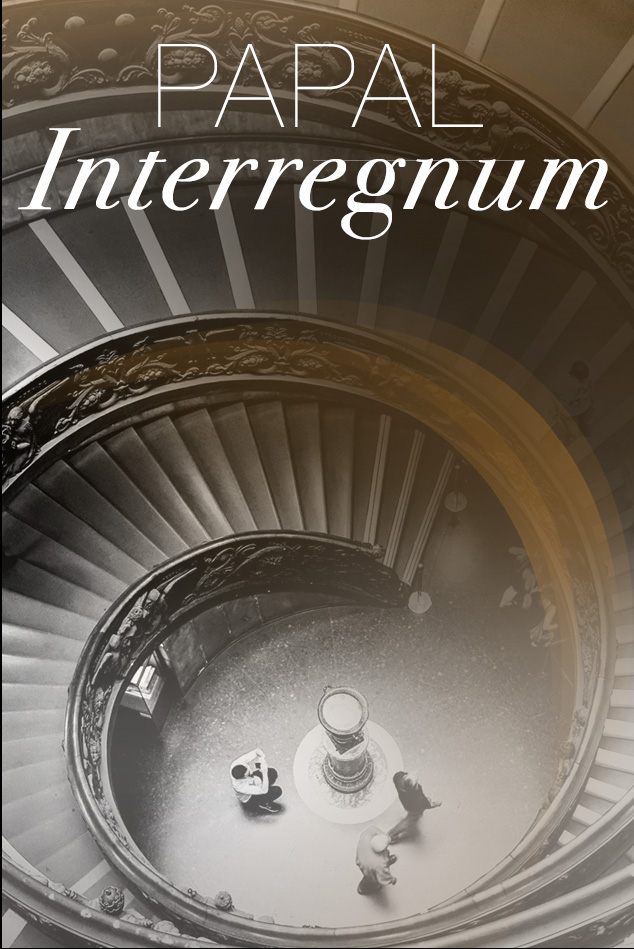Conclave is the unique name given to the gathering of the Cardinals to elect a Pope. The Cardinal Electors, as they are known, along with certain assistants, are sequestered away from any contact with the outside world, in living quarters inside Vatican City. The secrecy of the Conclave is absolute, even from other Cardinals not themselves Electors. Only a Pope can grant the faculty of discussing the Conclave with anyone not present.
From the time of the vacancy of the Apostolic See until the beginning of the Conclave, no less than 15 full days, and no more than 20, may elapse. This means that the Conclave may begin no earlier than the 16th Day of the Interregnum, nor start later than the 21st Day.
Cardinal Electors who have been legitimately delayed, or who leave for a reason recognized in law, may enter, or re-enter, the Conclave while it is in progress. The judgment regarding whether the reason is legitimate rests with the majority of the Cardinal Electors who are present.
As a rule, on the morning of the first day of the Conclave the Cardinal Electors gather in St. Peter’s Basilica, or another place as may be determined, to celebrate a Votive Mass for the Election of the Pope. In the afternoon they gather in the Pauline Chapel of the Apostolic Palace. Invoking the assistance of the Holy Spirit with the Veni Creator Spiritu, they process to the Sistine Chapel. There they take a solemn oath to observe the prescriptions of the law governing the election, to observe the secrecy obliged, to not assist any secular power which may try to influence the election, and if elected to faithfully carry out the Petrine Office, and to protect the spiritual and temporal rights of the Holy See.
After the last Cardinal Elector has taken the oath, the Master of Papal Liturgical ceremonies gives the order Extra omnes, commanding everyone not authorized to remain to leave the Chapel. Besides the Electors, only the Master of Papal Liturgical Ceremonies and the ecclesiastic chosen to give a meditation to the Cardinals on the seriousness of their duties, remains. When the meditation has been concluded, both of these men depart the Sistine Chapel.
After the Cardinals recite prayers provided in the proper Ordo for the Conclave, the Cardinal Dean inquiries if any Electors have questions concerning the norms and procedures. Once these are clarified, if a majority of the Cardinals agree the election can begin.
After all ballots are in, including those brought from the sick by the Infirmari, the 1st Scrutineer shakes the receptacle several times to mix the ballots. Then the 3rd Scrutineer counts them, placing them in a second, empty, receptacle. If the number of ballots does not equal the number of electors, they are burned, and a second vote taken immediately. Otherwise, the Scrutineers proceed to tabulate the vote. Sitting at a table in front of the altar, the 1st Scrutineer silently reads the name on a ballot, passes it to the 2nd Scrutineer who does likewise, and then passes it to the 3rd Scrutineer, who reads the name aloud and then writes it down. Each Elector also writes it down on a sheet provided for this purpose. The ballot is then pierced with a needle and placed on a thread for security.
When all ballots have been read the Scrutineers tabulate the vote by individuals receiving votes. They do this on a separate sheet of paper from that on which they were first listed. The Revisers then verify the results. If two-thirds of the votes have been cast for the same person an election has occurred. In which case, the Scrutineers, with the assistance of the Secretary of the Conclave and the Masters of Ceremony, who are re-admitted to the Conclave at this point, proceed to burn the ballots. However, if no election occurred and it was the first ballot of the session they proceed to vote again. After the second ballot the ballots of both sessions are burned, whether an election occurred or not.
The Scrutineers are three Cardinal Electors chosen by lot to gather and count the ballots. They stand at the altar as the Electors come up individually to deposit their votes. One of them also collects the votes of those present who are not physically able to come up to the altar. Afterwards, sitting at a table in front of the altar they tabulate the ballots to determine if an election has occurred.
The Infirmarii are three Cardinal Electors chosen by lot to take ballots to Electors who although within the enclosure of the Conclave are too sick to be present in the Sistine Chapel. They take with them a locked box which, having been shown to the other Electors to be empty, receives the votes of the infirm. They return it unopened to the Scrutineers.
The Revisers are 3 Cardinal Electors chosen by lot to check the ballot count and the notes of the Scrutineers to determine if the tabulation of the ballots was carried out exactly and faithfully.
After the junior Cardinal Deacon has re-admitted the Secretary of the College and the Master of Papal Liturgical Ceremonies, the Cardinal Dean, or, the Cardinal who is first in order and seniority, goes to the one elected and asks,
Do You Accept Your Canonical Election as Supreme Pontiff?
With consent he becomes Bishop of Rome and Pope. The Cardinal Dean then asks,
By What Name Do You Wish to be Called?
The Master of Papal Liturgical Ceremonies, with the witness of the two Masters of Ceremonies (who are now summoned), draw up a document certifying the consent of the one elected and the name he has chosen.
Following certain formalities prescribed in the ritual for the Conclave, each Cardinal comes forward in turn and makes an act of homage and obedience to the new Pope. An act of thanksgiving is then made. Following the vesting of the Pope the senior Cardinal Deacon announces from the loggia of St. Peter’s to those gathered in the Square that we have a Pope (Habemus papam) and what name he has taken. The newly elected Pope then comes out to address and bless the City and the World (Urbi et Orbi).
The Conclave is concluded when the new Pope assents to his election, unless he determines to keep it in session longer for some reason.
Yes, a Cardinal who is not an Elector, a bishop who is not a Cardinal, a priest, or theoretically a layman, could be elected Pope. If he is not present in the Vatican the ritual for the Conclave specifics a procedure for obtaining his consent. If he is not a bishop he would have to be ordained one before he would become Pope.
If any ballot produces an election those ballots are burned in a stove set up in the Sistine Chapel together with a chemical which produces a white smoke. This signals to Rome and the World that a Pope has been elected. If, however, the first vote of a session does not produce an election they proceed to a second vote. If that, too, fails to elect a Pope, the ballots of both votes are burned with wet straw, producing black smoke.
Pope Mark (336) decided that the Bishop of Ostia, the port-city of Rome, should consecrate Popes. At this period in history, the electee was either a deacon or a priest of Rome, and so consecration to the episcopacy inaugurated his papacy. Today, the Cardinal Bishop of Ostia is the Dean of the College of Cardinals and retains the right to consecrate the Pope if he is not already a bishop.
Most of the early Popes kept their own names upon election. However, when the Roman priest Mercury was elected in 533 he took the name John II, so the Church would not have a Pope named after a pagan god. Thus began the practice of taking a new name which today is taken for granted.
A number of Eastern Catholics of Greek or Syrian origin have been elected Pope. The last Pope to be from the East, however, was Pope Zachary (741-52).
Prior to the election of Marinus I in 882, the Popes had been chosen from among priests and deacons. Upon consecration to the episcopacy they became capable of being Pope and were, therefore, in that moment of consecration made both bishop and Pope. Bishops were not chosen because they were considered wedded to their diocese, and so the transference of a bishop from one diocese to another was considered uncanonical. Marino was already a bishop, however, so instead of being consecrated he was enthroned. After this time the practice of electing bishops occurred more and more frequently, so that it has become the norm. Since a bishop is already capable of being Pope, the electee becomes Pope in the moment of his acceptance of his election.
Over the centuries the Popes instituted various election reforms aimed at limiting or removing the external influences of emperors, kings, Roman nobility and clerical factions, who sought to elect their candidate or demanded their consent for election validity. Many reforms did not last, of course, especially concerning the issue of "investiture" (secular princes requiring their consent for the election of bishops in their territory). However, the free process that the Church has come to take for granted is the result of the continual struggle to free the papacy from secular or ecclesiastical electioneering. See also History of Papal Electoral Law
In 752 the man elected to succeed Pope Zachary took the name Stephen II. However, since he died before being officially consecrated, by the canon law of the day he was not considered the Pope yet. Soon thereafter, a different Stephen took the name Stephen II . Almost a thousand years later the official numbering was changed. The short-lived Stephen II is still NOT listed among the Popes, but his name is accounted for by the renumbering of the listed Stephens, so that the official Stephen II is now Stephen II (III). This numbering change in the official list was applied to all the Stephens, down to Stephen IX (X) in 1057. However, since there have been no new Stephens since the renumbering, no Pope has had to decide which number of Stephen to take next.
The record of recent Conclaves, the last 100 years, shows that the College elects a new Pope on average on the 3rd day in the afternoon, after about 8 ballots.
Pius X, 1903: 4 days, 7 ballots
Benedict XV, 1914: 3 days, 10 ballots
Pius XI, 1922: 5 days 14 ballots
Pius XII, 1939: 2 days, 3 ballots
John XXIII, 1958: 4 days, 11 ballots
Paul VI, 1963: 3 days, 6 ballots
John Paul I, 1978: 2 days, 4 ballots
John Paul II, 1978: 3 days, 8 ballots
Benedict XVI, 2005: 2 days, 4 ballots
Francis, 2013: 2 days, 5 ballots

